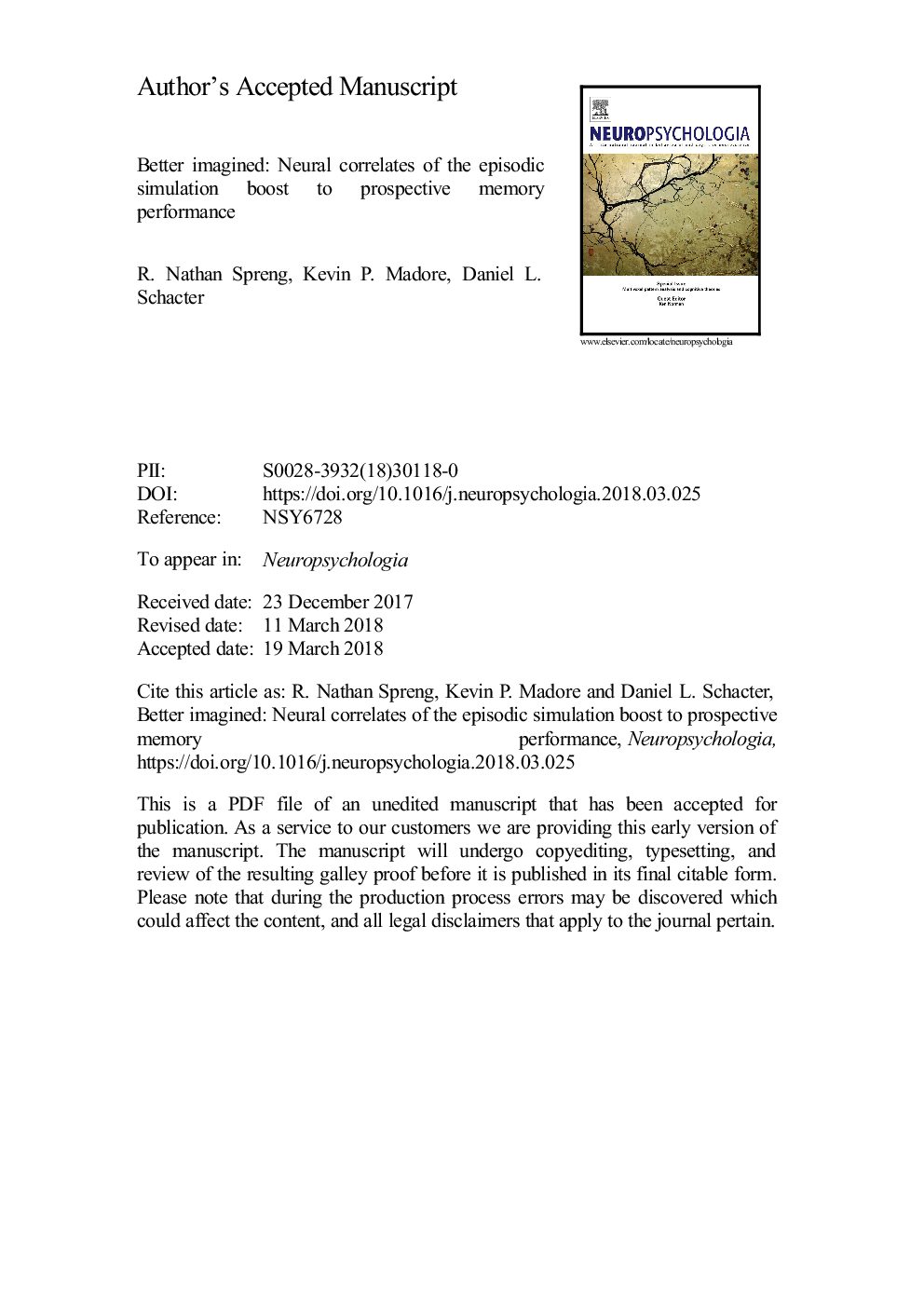ترجمه فارسی عنوان مقاله
بهتر تصور کنید: همبستگی های عصبی از افزایش شبیه سازی اپیزودیک به عملکرد حافظه آینده
عنوان انگلیسی
Better imagined: Neural correlates of the episodic simulation boost to prospective memory performance
| کد مقاله | سال انتشار | تعداد صفحات مقاله انگلیسی |
|---|---|---|
| 119369 | 2018 | 22 صفحه PDF |
منبع

Publisher : Elsevier - Science Direct (الزویر - ساینس دایرکت)
Journal : Neuropsychologia, Volume 113, May 2018, Pages 22-28
ترجمه چکیده
شبیه سازی اپیزودیک یک فرآیند سازگار است که می تواند فعالیت هدفمند و موفقیت برنامه ریزی را پشتیبانی کند. ما معماری عصبی مرتبط با بهبود شبیه سازی اپیزودیک را به احتمال وقوع اقدامات آینده با جداسازی مناطق مغز مرتبط با این تسهیل در یک پارادایم حافظه احتمالی مورد بررسی قرار دادیم. شرکت کنندگان با تصمیم گیری های لغوی / غیرمستقیم، تصمیم گیری لغوی را انجام دادند، به طوری که به ندرت اتفاق می افتاد که کلمات هدف هدف حافظه آینده نیاز به پاسخ دستی از پیش تعیین شده دارند. قبل از اسکن، شرکت کنندگان در معرض دو لیست از اهداف حافظه آینده: حیوانات و ابزار قرار گرفتند. در یک طراحی کاملا متعادل، شرکت کنندگان یک قافیه را به یک لیست هدف اضافه کردند و تصادف آنها را (شبیه سازی اپیزودیک) با کلمات هدف در لیست دیگر تصور کردند. شبیه سازی اپیزودیک با تکیه بر کارهای رفتاری قبلی، بهبود عملکرد حافظه آینده را بهبود بخشید. فعال سازی مغز در تجزیه و تحلیل خرده مقیاس های جزئی چند متغیره انجام شد. نسبت به بلوک های تصمیم گیری واژگانی بدون نیاز به حافظه آینده، حافظه احتمالی پایدار، مشاهدات پیشین فعال سازی قطبی جلو را تکرار کرد. به طور کلاسیک، قصد پاسخ دادن به اهداف شبیه سازی شده، بیش از حد اهداف قافیه، درگیر زوایای پیشانی و زاویه ای متوسط، و قوزک پایینی و پیشانی فکری است. فعالیت های گذرا در ارتباط با اهداف حافظه آینده نگر، نشان دهنده فعال شدن برای اهداف شبیه سازی شده در قشر مدرن پیش فرنتال، سینگوال خلفی، لوب طولانی جانبی و پارگی لوبال پایین است. در مقابل، هدف از قافیه، بیشتر به سمت چپ لگنال دو طرفه قشر پیشانی جلو و انسداد قدام وارد می شود. شبیه سازی اپیزودیک، به طور موثر استراتژی مدیریت اجرایی را تغییر می دهد و عملکرد عملکرد را افزایش می دهد. این نتایج با یک رویکرد فزاینده ای از شواهد به دست می دهد که کنترل اجرایی و تعاملات منطقه پیش فرض شبکه را در رفتار انطباقی، هدفی هدایت می کند.

